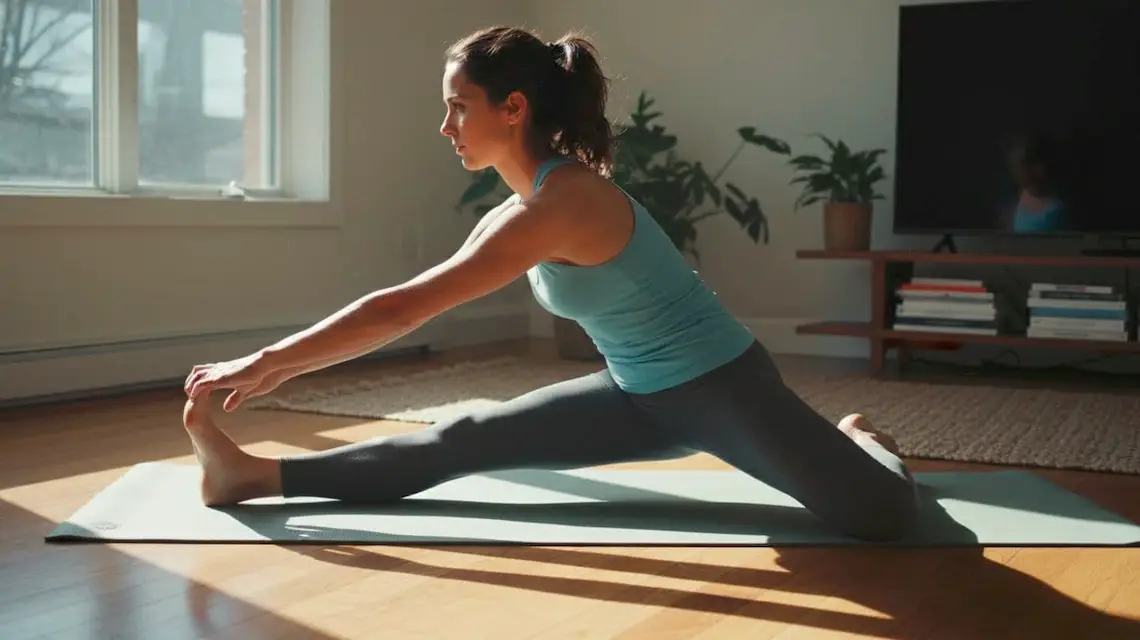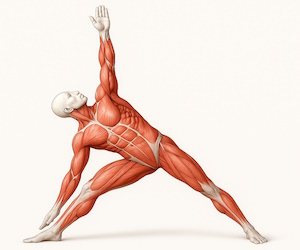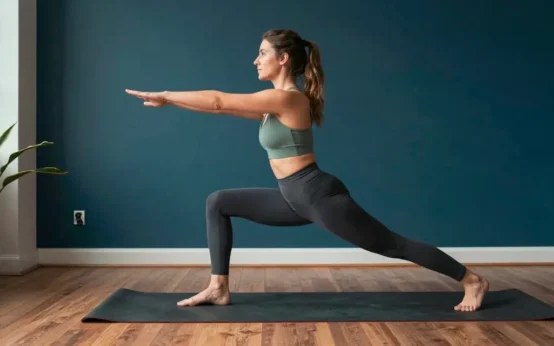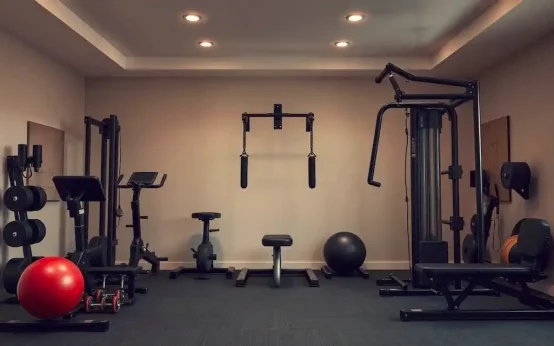Tight hips, rounded shoulders, a stiff neck, a restless mind. Stretching helps all of it. It eases soreness, improves posture, and calms stress. But how many times a day should you do stretching exercises? The quick answer: most people do best with 2 to 3 short sessions spread through the day, plus a dynamic warm up before workouts.
The best stretching frequency depends on your goals, age, and activity level. Think of two main types. Dynamic stretching is moving through range and works best before activity. Static stretching is holding a position and works best after exercise or in separate sessions. Use both, but place them well.
In this guide, you get a simple daily plan, clear rules by goal, and smart safety tips you can use today. If you want an easy daily stretching routine, you will find it here. You will also see how stretching frequency per day changes for desk work, workouts, and flexibility goals. Ready to feel looser and move better?
How many times a day should you do stretching exercises? The short answer by goal
Here is the simple rule: aim for 1 to 2 mini sessions per day, each 5 to 10 minutes. Add dynamic moves before any workout, and finish with static holds after. Short, consistent work beats long, rare sessions every time.
Consistency matters more than marathon stretching. You are training your nervous system and tissues to accept new range. A few minutes, done daily, pays off.
Quick rules by goal:
- General health and posture: 1 to 2 times per day, 5 to 10 minutes each. Keep it light and repeatable.
- Desk workers and drivers: 2 to 3 short breaks spread out. Think every 60 to 90 minutes.
- If you work out: dynamic warm up before, static cool down after. That post workout session can count as one of your daily sessions.
- Flexibility gains: target tight areas twice a day on most days. Use moderate holds and no forcing.
- Sore or irritated tissue: reduce intensity or hold time. Allow 24 to 48 hours for recovery.
Hold times and reps:
- Dynamic stretching: 8 to 12 controlled reps per move, 1 to 2 sets.
- Static stretching: 15 to 30 seconds per hold for general mobility. Go up to 30 to 60 seconds for very tight muscles, 2 to 4 sets per muscle.
Special note: if you have a medical condition, hypermobility, or an injury, you may need a customized plan from a pro. Ask a physical therapist or qualified coach for guidance on how often you should stretch each day.
General health and posture: 1 to 2 mini sessions a day
Short sessions work because your body loves frequent, gentle nudges. Five to ten minutes in the morning and/or evening is enough to ease stiffness and reset posture.
Build a simple circuit that hits common tight spots:
- Hips: half kneeling hip flexor stretch
- Hamstrings: seated or strap hamstring stretch
- Chest: doorway pec stretch
- Upper back: thoracic open books or a puppy pose
- Calves: wall calf stretch
- Lats: child’s pose with side reach
Breathe slowly. Relax into the hold. Aim for a mild stretch, not a fight. Over time, this lowers daily tension without leaving you sore.
Desk workers and stiff hips: 2 to 3 short breaks a day
Long sitting shortens hip flexors and rounds your spine. Use micro breaks every 60 to 90 minutes. Three to five minutes is enough, no gear needed.
Try this light routine:
- Standing hip flexor lunge, 20 seconds per side
- Seated hamstring reach, 20 to 30 seconds per side
- Wall chest opener, 20 seconds per side
- Neck side bends and turns, 5 slow reps each
- Wrist flexor and extensor stretch, 15 seconds each
Keep intensity low so you can repeat often. These are mobility snacks that keep stiffness from building up.
If you work out: dynamic before, static after
Warm up with 5 to 8 minutes of dynamic moves that match your sport or session. Think walking lunges with reach, high knees, leg swings, inchworms, and arm circles. Move with control, no rushing or bouncing.
After your workout, cool down with 5 to 10 minutes of static holds for the muscles you used. Lifted heavy squats? Stretch quads, hamstrings, glutes, and calves. Did a push session? Hit chest, lats, and triceps. This post workout block can count as one of your daily sessions.
Note for performance: heavy static holds right before sprinting or power lifts can reduce output. Keep pre workout static light or skip it.
Chasing flexibility gains: twice a day on target areas
Range improves with frequent, gentle exposure. For an area you want to change, stretch it in the morning and again in the evening. Use moderate holds and slow breathing.
Example: tight hamstrings. Do a 30 to 45 second strap stretch in the morning, 2 to 3 sets per side. Repeat in the evening. Do not force the end range or bounce. Aim for a 3 to 4 out of 10 stretch.
Most people notice change in 4 to 8 weeks with steady work. Track progress and adjust.
A simple daily stretching schedule you can stick to
You do not need a perfect routine. You need a plan that fits your day. Use these time blocks and swap moves based on your needs.
To remember sessions, set phone reminders, or pair them with habits. Stretch while the coffee brews, after lunch, or after brushing your teeth. Little anchors help consistency.
Use smooth control and avoid bouncing. Breathe with a slow nasal inhale and a longer exhale to help muscles relax. On busy days, even two minutes helps. On easy days, enjoy a longer block.
Workout days, place the dynamic session before training. Save static holds for after. On rest days, keep the morning and evening blocks and add a short midday break if you sit a lot.
Morning reset routine (about 5 minutes)
Wake up your joints and tissues:
- Cat cow or spinal roll downs, 6 to 8 reps
- World’s greatest stretch, 3 to 4 reps per side
- Calf rocks or ankle circles, 10 reps each
- Chest doorway stretch, 20 to 30 seconds
- Hip flexor half kneel stretch, 20 to 30 seconds per side
Cue: easy range and steady breath. You should feel looser, not tired.
Midday desk break stretch (3 to 7 minutes)
Chair friendly, repeatable sequence:
- Seated spinal twist, 15 to 20 seconds per side
- Seated hamstring reach, 20 to 30 seconds per side
- Standing hip flexor lunge, 20 seconds per side
- Wall pec opener, 20 seconds per side
- Neck side bends and turns, 5 slow reps each
Keep it light so you can do it 2 to 3 times per day.
Evening recovery and sleep prep (8 to 12 minutes)
Use longer, calmer holds to downshift your nervous system:
- Child’s pose breathing, 3 to 5 slow breaths
- Figure 4 glute stretch, 30 to 45 seconds per side
- Hamstring strap stretch, 30 to 60 seconds per side
- Thoracic open book, 6 slow reps per side
- Gentle neck stretch and wrist flexor stretch, 20 seconds each
Dim the lights. Focus on a long exhale to relax.
Workout day plan: where stretching fits
Placement matters:
- Before exercise: 5 to 8 minutes of dynamic moves that match the sport
- After exercise: 5 to 10 minutes of static holds for the muscles you used
- If time is tight: do a short evening recovery session instead
Skip heavy static holds right before power or sprint work. Keep the warm up active and focused on range and control.
Types of stretches and how often to do each
Stretching types can be simple. Use the right tool for the job and the day.
- Dynamic stretching: controlled movement through range. Best before activity or anytime as a light mobility snack.
- Static stretching: holding a position at a mild stretch. Best after workouts or as separate sessions.
- PNF stretching: contract relax style with a brief muscle contraction before deepening the stretch. Great for targeted gains, but intense.
- Mobility flows: continuous, low effort movements that move joints through range. Think of them as movement snacks.
Frequency guidance:
- Dynamic: before every workout, and sprinkle in a few reps during long sitting periods. Do 8 to 12 reps per move, 1 to 2 sets.
- Static: 1 to 2 times per day on tight areas. Hold 15 to 30 seconds for general mobility, up to 30 to 60 seconds for very tight muscles. Do 2 to 4 sets per muscle.
- PNF: 1 to 3 sessions per week per muscle group. Not multiple times per day.
- Mobility flows: as often as you like, every 30 to 90 minutes if you sit a lot.
Safety notes: go slow near end range. Do not bounce. Avoid pain. A mild pull is fine, a sharp or pinchy feel is not.
Dynamic stretching: how many reps, how often
Dynamic work means you move in control through a comfortable range. Use it before any sport or lift, and as a quick break during long sitting.
- Frequency: before every workout, plus short breaks during long sitting
- Reps: 8 to 12 per move, 1 to 2 sets
- Examples: leg swings, arm circles, walking lunges with reach, inchworms
Move with smooth tempo. Keep the range pain free.
Static stretching: holds, sets, and daily frequency
Static means you hold the position and wait. It helps you cool down and expand range over time.
- Frequency: 1 to 2 times per day on tight areas
- Holds: 15 to 30 seconds for general mobility, up to 30 to 60 seconds for very tight muscles
- Sets: 2 to 4 per muscle
Tip: a mild stretch sensation is fine. Sharp pain is not. If you hold your breath or tense up, ease off.
PNF stretching: safe use and weekly limits
PNF uses a brief contraction to help the muscle relax deeper. It works, but it is intense, so ration it.
- Frequency: 1 to 3 sessions per week per muscle group
- Protocol: start with a 20 to 30 second stretch. Then a 5 to 6 second gentle contraction against resistance. Then deepen for 15 to 30 seconds
- Best for targeted gains, not daily full body use
Avoid PNF right before heavy training. Place it on rest days or after light work.
Mobility flows and micro movements: move often, all day
Low effort movement snacks keep joints happy. They are easy to repeat and do not create fatigue.
- Frequency: as often as you like, every 30 to 90 minutes
- Ideas: spinal rotations, ankle circles, shoulder CARs, hip figure 8s
- Benefit: keeps joints lubricated and reduces stiffness without effort
Think of them as oil for your joints. Little and often.
Safety, progress, and when to back off
Good stretching feels like a gentle pull, not a fight. Before deeper holds, warm your tissues with 2 to 3 minutes of light movement or heat. A short walk, gentle joint circles, or a quick warm shower does the job.
Use a pain scale and keep stretches around a 3 to 4 out of 10. If pain spikes during a stretch, or lingers the next day, ease up on hold time, sets, or intensity.
Watch for red flags: sharp pain, tingling, numbness, swelling, or joint instability. Stop and get advice if these appear.
Special cases need extra care. Beginners should start with gentler ranges and fewer sets. Seniors benefit from balance safe positions, more support, and slower transitions. People with hypermobile joints should avoid hanging out at end range, and add light strength near those ranges. Recent injuries call for a plan from a pro.
Track progress with simple tests every 2 to 4 weeks. Keep notes on holds, sets, and how you feel. Small wins add up.
Signs you are stretching too much and what to do
Possible signs you are overdoing it:
- Sharp pain or joint pinching during or after
- Muscles sore for more than 48 hours
- Sleep disturbed by soreness
- Performance drop during workouts
- A feeling of instability at a joint
What to do:
- Shorten holds
- Reduce sets
- Switch to lighter mobility moves for a week
- Add rest days for that muscle group
- Check your form and range
Warm up, breathing, and pain scale for safe stretching
Use this checklist to stay safe:
- Warm tissues first with a short walk or easy joint circles
- Breathe slowly, with a longer exhale to relax
- Use a 0 to 10 scale, aim for a 3 to 4, not a 7
- Come out of positions slowly to avoid cramps or dizziness
These habits make each session safer and more effective.
Special cases: beginners, seniors, and hypermobile joints
Guidance by group:
- Beginners: start with 1 mini session daily, 15 to 20 second holds, 1 to 2 sets per muscle. Build up as your body adapts
- Seniors: prioritize support and stability. Use the floor, a chair, or a wall. Move slower between positions
- Hypermobile joints: avoid end range hanging. Add light strength work near end range, like isometric holds. Consider a coach or PT for a plan
Individual needs matter. Adjust based on how you feel the next day.
Track progress: flexibility goals you can measure
Simple tests help you see change:
- Fingertip to floor in a forward fold
- Wall pec stretch angle, note elbow height
- Seated hamstring reach, note how far you reach past your toes
- Ankle dorsiflexion knee to wall, measure distance from toes to wall
Retest every 2 to 4 weeks. Log holds and sessions. Celebrate small wins and adjust targets as needed.
Conclusion
How many times a day should you do stretching exercises? For most people, 2 to 3 short sessions spread through the day works best, with dynamic moves before workouts and static holds after. Keep it gentle, repeatable, and safe. Small daily habits beat long, rare sessions.
Start with 1 to 2 sessions of 5 to 10 minutes, then adjust based on how your body feels. Pick a morning, midday, and evening move and start today. Stay consistent and expect steady results in 4 to 8 weeks. Your body will thank you for the consistency.
Related post:
- Diastasis Recti Exercises: A Safe, Step-by-Step Plan
- Easy Stretching Exercises for Sciatica
- Gentle Yoga for Beginners
Daily Stretching: How Often Is Enough?
How many times a day should I stretch?
Most people do well with 1 to 2 short sessions a day. Aim for daily stretching if you sit a lot or feel tight. Consistency beats marathon sessions.
Is it better to stretch once a day or in short bouts?
Short bouts work best. Try 2 to 3 mini sessions, 5 to 10 minutes each. Spread them in the morning, midday, and evening.
How often should I stretch on workout days?
Do dynamic moves before training, one quick session. Do static stretching after training, one focused session. Keep each muscle group to 2 to 4 sets.
Should I stretch on rest days too?
Yes. Gentle stretching on rest days helps maintain range and reduces stiffness. Keep it light and pain free.
How long should I hold each stretch?
Hold static stretches 15 to 30 seconds, repeat 2 to 4 times. Total time per muscle, 60 seconds. Breathe and relax.
How many days per week is ideal?
At least 2 to 3 days a week maintains flexibility. Daily is better for gains or if you sit for long periods.
Can I stretch too often?
Yes. Stretching the same muscle hard many times a day can irritate tissue. Leave a few hours between sessions, and keep intensity low to moderate.
What if I work at a desk all day?
Do 2 to 3 mini breaks, 3 to 5 minutes each. Focus on hip flexors, hamstrings, chest, neck, and upper back. Add quick posture resets every hour.
How often should runners or lifters stretch?
Runners, do dynamic drills before runs and static stretches after. Lifters, move through full range in warmups and finish tight areas with 2 to 4 static sets. Add a short daily mobility routine if you lack range.
Morning or evening, which is better?
Both work. Morning loosens sleep stiffness. Evening helps you unwind and may improve sleep. Pick the time you will keep.
How often should I do dynamic vs static stretching?
Dynamic, before activity, once per workout. Static, after activity or separate from training, 1 to 2 times a day for tight areas.
How many stretches per muscle group?
Pick 1 to 2 effective moves per muscle. Do 2 to 4 sets per move, total 60 seconds per muscle group.
How quickly will daily stretching improve flexibility?
Most people see change in 2 to 4 weeks with daily work. Gains depend on starting range, age, and effort.
Should older adults stretch more often?
Daily gentle sessions help with stiffness and balance. Keep intensity low, avoid bouncing, and focus on hips, calves, hamstrings, chest, and ankles.
Is pain normal when stretching?
Mild tension is fine. Sharp pain, numbness, or joint pain is not. Ease off. If pain lasts, reduce frequency and seek a clinician’s advice.
Can hypermobile people stretch daily?
Be careful. Focus on control and strength more than long holds. If you stretch, use short holds and stop well before end range.
How often should I stretch an injured area?
Follow medical guidance. Early on, shorter and gentler sessions are safer. Pain rules the dose.
Do I need rest between stretch sessions?
Leave at least a few hours between focused sessions of the same muscle. This helps tissues adapt and calms nerves.
Is PNF stretching safe every day?
Keep PNF to 2 to 3 times per week per muscle, not daily. It is intense and can cause soreness if overused.
Any quick routine I can use daily?
Yes. Try 5 to 10 minutes: neck circles, thoracic rotations, hip flexor stretch, hamstring stretch, calf stretch, chest doorway stretch, and glute stretch. Hold each 20 to 30 seconds, repeat once.




 Beginner Cardio Workout at Home
Beginner Cardio Workout at Home  10 Stretching Exercises to Increase Height
10 Stretching Exercises to Increase Height  Menopause Workout: A Simple, Strong Plan
Menopause Workout: A Simple, Strong Plan  Best Home Gym Workout Equipment
Best Home Gym Workout Equipment  Exercise Tips Help You Look Great for Your Age
Exercise Tips Help You Look Great for Your Age  How to Stay Active With Back Pain
How to Stay Active With Back Pain